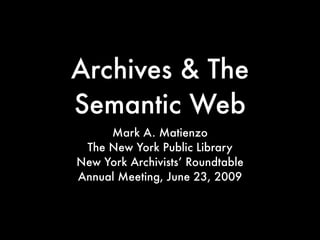
Archives & the Semantic Web
- 1. Archives & The Semantic Web Mark A. Matienzo The New York Public Library New York Archivists’ Round Table Annual Meeting, June 23, 2009
- 2. Disclaimer The following presentation, while factual, expresses opinions of my own and not of my employer, my coworkers, my family, etc.
- 3. Archives & The Web
- 4. The Web isn’t new, even to archivists.
- 12. The Web, at its essence, is about links.
- 13. We take links for granted in our work.
- 19. Links go beyond the easily accessible sort.
- 22. http://leopac4.nypl.org/ipac20/ipac.jsp? session=1O4572959KO37.4065&profile=dial--3&uri=link=1100083~!S908632~! 1100001~!1100087&aspect=basic&menu=search&ri=2&source=~! dial&term=Abbey+Theatre&index=SL
- 24. Further down the rabbit hole.
- 28. Computers don’t “do” implicit links.
- 29. Humans must correlate data on both ends.
- 30. These access points don’t link to anything.
- 31. The Semantic Web
- 32. (blame this guy) http://www.flickr.com/photos/tanaka/3212373419/
- 33. I have a dream for the Web [in which computers] become capable of analyzing all the data on the Web – the content, links, and transactions between people and computers. A ‘Semantic Web’, which should make this possible, has yet to emerge, but when it does, the day-to-day mechanisms of trade, bureaucracy and our daily lives will be handled by mac hines talking to machines. The ‘intelligent agents’ people have touted for ages will finally materialize. Tim Berners-Lee, Weaving The Web.
- 34. Linked Data is a way to link better. Dan Chudnov, Better Living Through Linking. http://onebiglibrary.net/story/tcdl-2009-talk-better-living-through-linking
- 35. Linked data is not a new concept in archives.
- 36. If the series becomes the primary level of classification, and the item the secondary level, a) items are kept in their administrative context and original order by physical allocation to their appropriate series, and b) series are no longer kept in any original physical order in a record or shelf group (if there is any such order) but simply have their administrative context and associations recorded on paper. Peter J. Scott, “The Record Group Concept: A Case For Abandonment,” American Archivist 29(4), 1966.
- 37. Peter J. Scott, “The Record Group Concept: A Case For Abandonment,” American Archivist 29(4), 1966.
- 38. Peter J. Scott, “The Record Group Concept: A Case For Abandonment,” American Archivist 29(4), 1966.
- 39. Design Principles 1. Use URIs for names of things 2. Use HTTP URIs so people can look up those names 3. Provide useful information in standard formats at those URIs 4. Include links to other URIs so people can discover more things Tim Berners-Lee, Linked Data - Design Issues. http://www.w3.org/DesignIssues/LinkedData.html
- 40. Naming things with URIs tells us where to find them.
- 41. Using HTTP (Web) URIs tells us how to find these things.
- 42. Providing data in standard formats tells us what that thing is.
- 43. EAD is not a standard format in this sense.
- 44. RDF 1. Resource Description Framework 2. Presents relationships in a simple data structure 3. We can draw graphs of those relationships 4. We can represent those relationships in multiple formats for computers Tim Berners-Lee, Linked Data - Design Issues. http://www.w3.org/DesignIssues/LinkedData.html
- 45. In RDF, we say some thing has a property with a certain value.
- 47. <http://matienzo.org/#me> foaf:firstName “Mark”. thing (Me) property value
- 48. An RDF Graph foaf:firstName “Mark” http://matienzo.org/#me
- 49. An RDF Graph foaf:based_near http://dbpedia.org/page/Brooklyn foaf:firstName “Mark” foaf:surname “Matienzo” http://matienzo.org/#me
- 50. Simply linking to things is not enough.
- 51. RDF graphs show why we link to other things.
- 52. These links say what the relationships are.
- 53. Links between things become crossreferences.
- 54. Precision improves with explicit links and “smart crawlers.”
- 59. @prefix dc: <http://purl.org/dc/elements/1.1/> . @prefix owl: <http://www.w3.org/2002/07/owl#> . @prefix rdf: <http://www.w3.org/1999/02/22-rdf-syntax-ns#> . @prefix rdfs: <http://www.w3.org/2000/01/rdf-schema#> . @prefix libris: <http://libris.kb.se/vocabulary/experimental#> . @prefix bibo: <http://purl.org/ontology/bibo/> . <http://libris.kb.se/resource/bib/4721351> rdfs:isDefinedBy <http://libris.kb.se/data/bib/4721351> . <http://libris.kb.se/resource/bib/4721351> rdf:type bibo:Book . <http://libris.kb.se/resource/bib/4721351> dc:title "The Abbey : Ireland's national theatre 1904-1979"@en . <http://libris.kb.se/resource/bib/4721351> dc:creator "Hunt, Hugh" . <http://libris.kb.se/resource/bib/4721351> dc:creator "Hugh Hunt" . <http://libris.kb.se/resource/bib/4721351> dc:type "text" . <http://libris.kb.se/resource/bib/4721351> dc:publisher "Columbia U.P" . <http://libris.kb.se/resource/bib/4721351> dc:date "1979" . <http://libris.kb.se/resource/bib/4721351> dc:description "U Can $ 33.60"@en . <http://libris.kb.se/resource/bib/4721351> dc:identifier <URN:ISBN:0231049064> . <http://libris.kb.se/resource/bib/4721351> bibo:isbn10 "0231049064" . <http://libris.kb.se/resource/bib/4721351> libris:held_by <http://libris.kb.se/resource/library/G> . <http://libris.kb.se/resource/bib/4721351> libris:held_by <http://libris.kb.se/resource/library/L> . <http://libris.kb.se/resource/bib/4721351> libris:held_by <http://libris.kb.se/resource/library/Li> . <http://libris.kb.se/resource/bib/4721351> libris:held_by <http://libris.kb.se/resource/library/U> . <http://libris.kb.se/resource/bib/4721351> libris:held_by <http://libris.kb.se/resource/library/Uh> . http://libris.kb.se/data/bib/4721351?format=text%2Frdf%2Bn3
- 61. Chronicling America http://chroniclingamerica.loc.gov/lccn/sn85066387/
- 62. NSDL Registry http://metadataregistry.org/
- 64. UK Archival Thesaurus http://www.w3.org/TR/2005/WD-swbp-skos-core-guide-20050510/
- 65. Archives de France “Thesaurus W” http://www.archivesdefrance.culture.gouv.fr/gerer/classement/normes-outils/thesaurus/
- 67. Barriers are both cultural and technical.
- 68. Archival description contains lots of implicit information.
- 69. “Inheritance” of data in multi-level description is highly implicit.
- 70. EAD is document-centric standard, not a data-centric standard.
- 71. EAC, a standard in development, is more data-centric.
- 72. Archival description, in its current state, is not computer-friendly.
- 73. Archival description, in its current state, is not Linked Data-friendly.
- 74. EAD needs to change to interoperate with EAC as well as other standards.
- 75. It is up to the archival community to steer the standards accordingly.
- 76. Thank You mark@matienzo.org http://matienzo.org/ http://twitter.com/anarchivist
